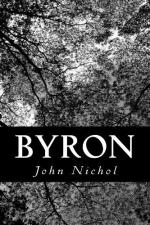About this time Byron seems to have entertained the idea of returning to England in the spring, i.e. after a year’s absence. This design, however, was soon set aside, partly in consequence of a slow malarian fever, by which he was prostrated for several weeks. On his partial recovery, attributed to his having had neither medicine nor doctor, and a determination to live till he had “put one or two people out of the world,” he started on an expedition to Rome.
His first stage was Arqua; then Ferrara, where he was inspired, by a sight of the Italian poet’s prison, with the Lament of Tasso; the next, Florence, where he describes himself as drunk with the beauty of the galleries. Among the pictures, he was most impressed with the mistresses of Raphael and Titian, to whom, along with Giorgione, he is always reverential; and he recognized in Santa Croce the Westminster Abbey of Italy. Passing through Foligno, he reached his destination early in May, and met his old friends, Lord Lansdowne and Hobhouse. The poet employed his short time at Rome in visiting on horseback the most famous sites in the city and neighbourhood—as the Alban Mount, Tivoli, Frascati, the Falls of Terni, and the Clitumnus—re-casting the crude first draft of the third act of Manfred, and sitting for his bust to Thorwaldsen. Of this sitting the sculptor afterwards gave some account to his compatriot, Hans Andersen: “Byron placed himself opposite to me, but at once began to put on a quite different expression from that usual to him. ’Will you not sit still?’ said I. ‘You need not assume that look.’ ‘That is my expression,’ said Byron. ‘Indeed,’ said I; and I then represented him as I wished. When the bust was finished he said, ’It is not at all like me; my expression is more unhappy.’” West, the American, who five years later painted his lordship at Leghorn, substantiates the above half-satirical anecdote, by the remark, “He was a bad sitter;




